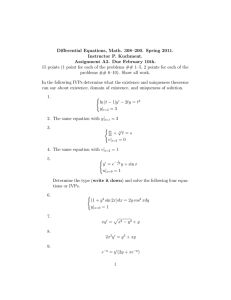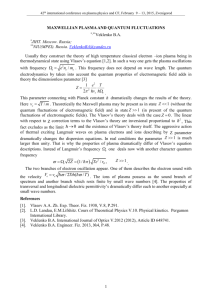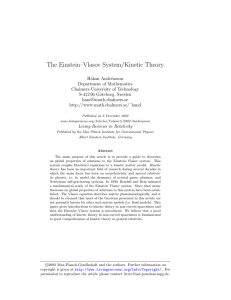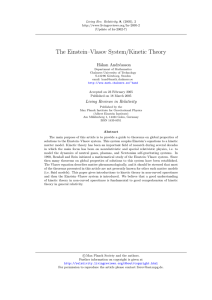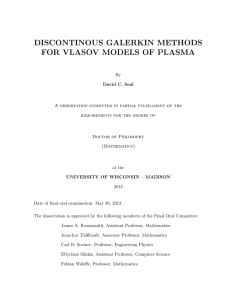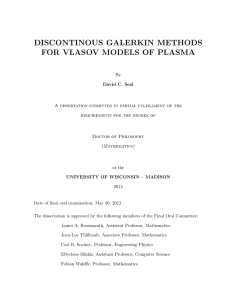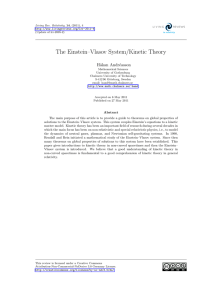ON LOCAL SMOOTH SOLUTIONS FOR THE VLASOV EQUATION PETER ZHIDKOV
advertisement
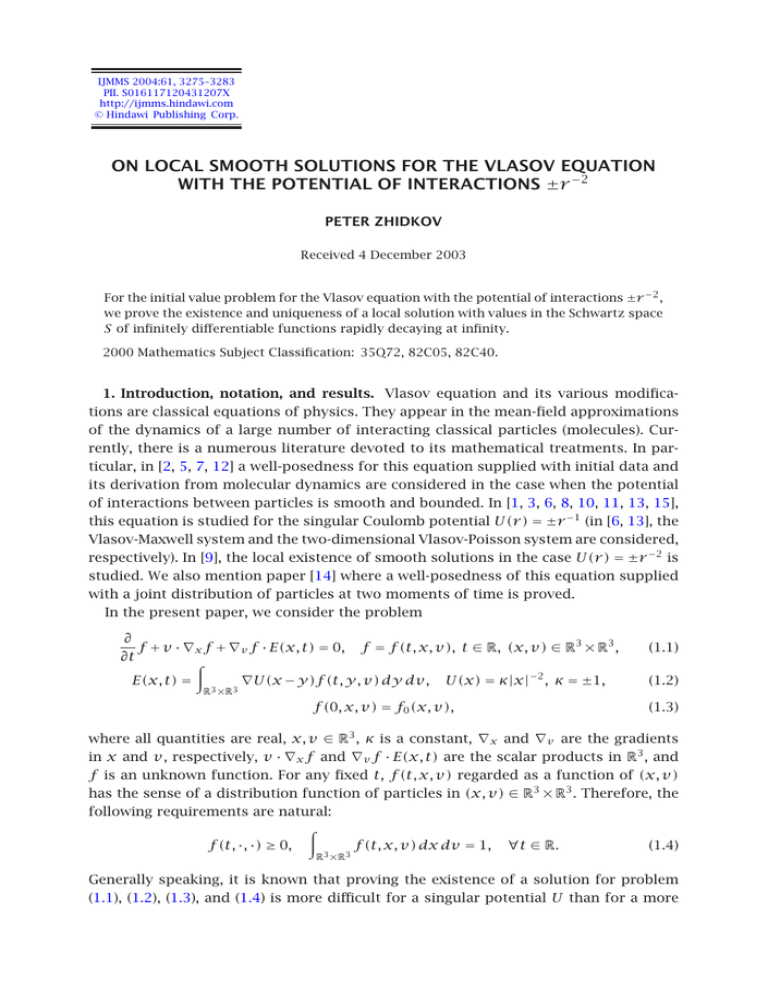
IJMMS 2004:61, 3275–3283
PII. S016117120431207X
http://ijmms.hindawi.com
© Hindawi Publishing Corp.
ON LOCAL SMOOTH SOLUTIONS FOR THE VLASOV EQUATION
WITH THE POTENTIAL OF INTERACTIONS ±r −2
PETER ZHIDKOV
Received 4 December 2003
For the initial value problem for the Vlasov equation with the potential of interactions ±r −2 ,
we prove the existence and uniqueness of a local solution with values in the Schwartz space
S of infinitely differentiable functions rapidly decaying at infinity.
2000 Mathematics Subject Classification: 35Q72, 82C05, 82C40.
1. Introduction, notation, and results. Vlasov equation and its various modifications are classical equations of physics. They appear in the mean-field approximations
of the dynamics of a large number of interacting classical particles (molecules). Currently, there is a numerous literature devoted to its mathematical treatments. In particular, in [2, 5, 7, 12] a well-posedness for this equation supplied with initial data and
its derivation from molecular dynamics are considered in the case when the potential
of interactions between particles is smooth and bounded. In [1, 3, 6, 8, 10, 11, 13, 15],
this equation is studied for the singular Coulomb potential U(r ) = ±r −1 (in [6, 13], the
Vlasov-Maxwell system and the two-dimensional Vlasov-Poisson system are considered,
respectively). In [9], the local existence of smooth solutions in the case U(r ) = ±r −2 is
studied. We also mention paper [14] where a well-posedness of this equation supplied
with a joint distribution of particles at two moments of time is proved.
In the present paper, we consider the problem
∂
f + v · ∇x f + ∇v f · E(x, t) = 0,
∂t
E(x, t) =
R3 ×R3
f = f (t, x, v), t ∈ R, (x, v) ∈ R3 × R3 ,
∇U (x − y)f (t, y, v) dy dv,
U(x) = κ|x|−2 , κ = ±1,
f (0, x, v) = f0 (x, v),
(1.1)
(1.2)
(1.3)
where all quantities are real, x, v ∈ R3 , κ is a constant, ∇x and ∇v are the gradients
in x and v, respectively, v · ∇x f and ∇v f · E(x, t) are the scalar products in R3 , and
f is an unknown function. For any fixed t, f (t, x, v) regarded as a function of (x, v)
has the sense of a distribution function of particles in (x, v) ∈ R3 × R3 . Therefore, the
following requirements are natural:
f (t, x, v) dx dv = 1, ∀t ∈ R.
(1.4)
f (t, ·, ·) ≥ 0,
R3 ×R3
Generally speaking, it is known that proving the existence of a solution for problem
(1.1), (1.2), (1.3), and (1.4) is more difficult for a singular potential U than for a more
3276
PETER ZHIDKOV
regular one. Also, although the Vlasov equation appeared for the first time with the
Coulomb potential U (r ) = ±r −1 for a description of plasma, it is well known that in
statistical physics potentials with higher singularities occur, for example, the following one, the so-called Lennard-Jones potential, is known: U(r ) = Ar −12 − Br −6 . So, the
author of the present paper believes that considerations of Vlasov equations for potentials with singularities of degrees higher than r −1 make sense. Here we consider
the case U (r ) = ±r −2 proving the existence and uniqueness of a local smooth solution
of the problem (1.1), (1.2), (1.3), and (1.4). This case is critical in a sense. A treatment
of the problem in the case U (r ) = r −2−a with a > 0 is still left open. As for the case
U(r ) = r −a with a ∈ (1, 2), here the problem becomes simpler, and our methods still
hold for it.
The existence and uniqueness of a smooth solution of problem (1.1), (1.2), (1.3), and
(1.4) is proved in [9]. In fact, we prove a similar result by using another method that
allows to treat the problem in a simpler and shorter way. We do not exploit the known
method of characteristics but we use an approach known in the theory of nonlinear
PDEs, too. Our results also hold for potentials of interaction of a more general kind
U(r ) = κr −2 +U1 (r ), where U1 (r ) is a function continuously differentiable everywhere
except maybe the point r = 0 where it may have a singularity of order |r |a−2 with
0 < a < 2 and U1 (r ) must satisfy certain conditions of decay at infinity.
Now, we introduce some notation. Let
m1 +m2
g(x, v)
sup
|x| |v| <∞ .
∂x m1 ∂v m2 (x,v)∈R3 ×R3
(1.5)
S= g(x, v)∈ C R3 ×R3 :∀ki , mi = 0, 1, 2, . . . ,
∞
k1
k2∂
The linear space S is equipped with a topology of open subsets becoming a complete
topological space. This topology is generated by the system of seminorms
pk,m (g) =
qk,m (g) =
R3 ×R3
R3 ×R3
1 + |x|
2 k1
1 + |v|
2 k2
3
i=1
1 + |x|
2 k1
1 + |v|
2 k2
3
i=1
∂ m g(x, v)
∂xim
∂ m g(x, v)
∂vim
1/2
2
dx dv
,
(1.6)
,
(1.7)
1/2
2
dx dv
where k = (k1 , k2 ) with ki , m = 0, 1, 2, . . . . By C(I; S), where I ⊂ R is an interval, we
denote the linear space of all continuous functions g : I → S such that each seminorm
pk,m (g(t)) and qk,m (g(t)) is bounded uniformly in t ∈ I.
Our main result here is the following.
Theorem 1.1. Let f0 ∈ S and satisfy (1.4). Then, there exists T > 0 such that problem
(1.1), (1.2), (1.3), and (1.4) has a unique local solution f(t, x, v) satisfying f(t, ·, ·), ft(t, ·, ·)
∈ C([−T , T ]; S).
Remark 1.2. As is shown in [4], if κ > 0, then problem (1.1), (1.2), (1.3), and (1.4)
possesses solutions blowing up in finite intervals of time. So, in this case, generally
speaking, solutions we consider can be not continuable onto the entire real line t ∈ R.
ON LOCAL SMOOTH SOLUTIONS FOR THE VLASOV EQUATION . . .
3277
2. Proof of the theorem. Let ω(·) be a nonnegative even C ∞ -function in R3 with a
compact support satisfying R3 ω(x) dx = 1 and let ωn (x) = n3 ω(nx), n = 1, 2, 3, . . . .
Set Un (x) = (U ωn )(x), where the star means the convolution. Consider the following
sequence of regularizations of problem (1.1), (1.2), (1.3), and (1.4):
ftn + v · ∇x f n + ∇v f n · En (x, t) = 0, f n = f n (t, x, v),
En (x, t) =
∇Un (x − y)f n (t, y, v) dy dv,
(2.1)
f n |t=0 = f0 ∈ S,
(2.3)
R3 ×R3
f n (t, ·, ·) ≥ 0,
R3 ×R3
f n (t, x, v) dx dv ≡ 1,
n = 1, 2, 3, . . . .
(2.2)
(2.4)
The following statement is a corollary of results in [2, 5, 7, 12].
Proposition 2.1. For each n, problem (2.1), (2.2), (2.3), and (2.4) has a unique global
solution f n (t, x, v) that for any t0 > 0 belongs to C((−t0 , t0 ); S) together with ftn (t, x, v).
Denote (Tn g)(x) = R3 ×R3 ∇Un (x − y)g(y, v) dy dv, where g ∈ S. Note that
∂ m g(x, ·)
∂ m Tn g (x)
(x),
m ≡ Tn
m
m
m
m
m
∂x1 1 ∂x2 2 ∂x3 3
∂x1 1 ∂x2 2 ∂x3 3
m = m1 + m2 + m3 .
(2.5)
Lemma 2.2. There exists C > 0 such that (Tn g)
L2 (R3 ) ≤ Cp(0,2),0 (g) for all g ∈ S
and n.
Proof. As is well known, there exists C1 > 0 such that
∇U (x − y)h(y) dy R3 ×R3
L2 (R3 )
≤ C1 h
L2 (R3 ) ∀h ∈ S R3 .
(2.6)
Also,
R3 ×R3
∇Un (x − y)g(y, v) dy dv =
R3 ×R3
∇U(x − y) ωn x g (y, v) dy dv
(2.7)
and ωn h
L2 (R3 ) ≤ h
L2 (R3 ) for all h ∈ S(R3 ). Hence, we have, for g ∈ S,
∇Un (x − y)g(y, v) dy dv R3 ×R3
L2 (R3 )
1 + |v|2 g(·, v) dv = C1 R3
1 + |v|2
L
≤ C1 g(·, v) dv R3
≤C
3
2 (R )
R3 ×R3
L2 (R3 )
2
1 + |v|2 g 2 (x, v) dx dv
1/2
= Cp(0,2),0 (g).
(2.8)
Let [a] be the maximal integer not larger than a real a and let an integer m0 > 0 be
such that each Sobolev space H l+m0 (R3 ×R3 ) with a positive integer l is embedded into
C l (R3 × R3 ) (in fact, m0 > 3). Let m1 = 2m0 + 2. Everywhere k denotes k1 + k2 . In what
3278
PETER ZHIDKOV
follows, we exploit the following embeddings (g ∈ S):
2 1/2
∂lg
n
r
R3 ×R3
∂xi ∂vj
≤ C pk,0 (g) + pk,s (g) + qk,s (g) ,
pk,m (g) ≤ C p(k,0),m (g) + p(0,k),m (g) ,
qk,m (g) ≤ C q(k,0),m (g) + q(0,k),m (g) , m = 0, 1, 2, . . . ,
(2.9)
l
2 k1 /2
2 k2 /2 ∂ g(x, v) ≤ C pk,0 (g) + pk,m+l (g) + qk,m+l (g) ,
sup 1 + |x|
1 + |v|
∂x n ∂v r (x,v)
j
i
1/2
2
l
2 k1
2 k2 ∂ g(x, v)
dv
sup
1 + |x|
1 + |v|
n
r
∂xi ∂vj
x
R3
≤ C pk,0 (g) + pk,l+m (g) + qk,l+m (g) ,
k k
dx dv 1 + |x|2 1 1 + |v|2 2
where 0 ≤ l = n + r ≤ s, i, j = 1, 2, 3, and m = m0 , m0 + 1, m0 + 2, . . . . To prove them,
consider the partition of R3 ×R3 by cubes Kα defined by ri −1 ≤ xi ≤ ri , pj −1 ≤ vj ≤ pj ,
where ri , pj run over all integers. Observe that for any integer k1 , k2 ≥ 0 there exist
0 < c < C such that
k k
sup(x,v)∈Kα 1 + |x|2 1 1 + |v|2 2
c≤
k k ≤ C
inf (x,v)∈Kα 1 + |x|2 1 1 + |v|2 2
(2.10)
for all α. Now, inequalities (2.9) follow by standard Sobolev embeddings applied to each
cube Kα with further summing in α.
Lemma 2.3. There exist T > 0 and C > 0 such that
n
n
n
2
2
2
f (t, ·, ·) + p(0,2),m
f (t, ·, ·) + q(0,2),m
f (t, ·, ·) ≤ C
p(0,2),0
1
1
(2.11)
for all t ∈ [−T , T ] and all n = 1, 2, 3, . . . .
Proof. We derive our estimates only for t > 0 because the case t < 0 can be treated
by analogy. Integrating by parts in v using the independence of En (x, t) of v, estimating En (x, t) by p(0,2),0 (f n (t, ·, ·)) + p(0,2),m1 (f n (t, ·, ·)) according to the Sobolev embedding of H m1 (R3 ) into C(R3 ), Lemma 2.2, and the fact that ∂ m1 En (x, t)/∂x m1 =
Tn (∂ m1 f n (t, x, v)/∂x m1 ), and applying Hölder’s inequality, we have, from (2.1),
n
1 d 2
f (t, ·, ·)
p
2 dt (0,2),0
2
=−
1 + |v|2 f n (t, x, v)fvn (t, x, v) · En (x, t) dx dv
3
3
R ×R
2
1 + |v|2 v · En (x, t) f n (t, x, v) dx dv
=2
3
3
R ×R
n
2
≤ Cp(0,2),0
f (t, ·, ·) p(0,2),0 f n (t, ·, ·) + p(0,2),m1 f n (t, ·, ·) .
(2.12)
ON LOCAL SMOOTH SOLUTIONS FOR THE VLASOV EQUATION . . .
3279
Consider
1 d 2
p(0,2),m1 f n (t, ·, ·) = −
2 dt
×
R3 ×R3
m1 3
2 n(m )
dx dv 1 + |v|2
fxi 1 (t, x, v)
i,j=1
l+1 f n (t, x, v) ∂ m1 −l
m1 ∂
l
l=0
∂vj ∂xil
m1 −l
∂xi
(2.13)
En,j (x, t).
To estimate the term with the (m1 + 1)st derivative of f n , we integrate by parts in v
and use the fact that En (x, t) does not depend on v. Also, as above, we estimate the
uniform norm of En (x, t) by p(0,2),0 (f n (t, ·, ·))+p(0,2),m1 (f n (t, ·, ·)) and apply Hölder’s
inequality. To estimate all other terms in the right-hand side of equation (2.13), observe that the order of one of the derivatives in (1 + |v|2 )(∂ l+1 f n (t, x, v)/∂vj ∂xil ) and
m −l
(∂ m1 −l /∂xi 1 )En,j (x, t) is not larger than m0 + 1 and therefore, either one has
∂ m1 −l E (x, t) n,j
≤ C p(0,2),0 f n (t, ·, ·) + p(0,2),m1 f n (t, ·, ·)
(2.14)
m1 −l
3
∂x
i
C(R )
or the estimate in the fourth string of (2.9) takes place; in addition, we estimate the
L2 -norm of the other cofactor with the derivative of order larger than m0 + 1 by the
same quantity corresponding to it. So, applying Hölder’s inequality, we arrive at the
estimate
n
1 d 2
f (t, ·, ·)
p
2 dt (0,2),m1
n
2
≤ Cp(0,2),m
f (t, ·, ·) p(0,2),0 f n (t, ·, ·) + p(0,2),m1 f n (t, ·, ·)
1
m0 +1
m1 −1
3
2 m1
+
+
1 + |v|2
3 3 dx dv
l
R ×R
l=0
l=m0 +2 i,j=1
∂ l+1 f n (t, x, v) ∂ m1 −l En,j (x, t) n(m1 )
× fxi
(t, x, v)
m −l
∂vj ∂xil
∂xi 1
n
≤ Cp(0,2),m1 f (t, ·, ·)
× p(0,2),0 f n (t, ·, ·) + p(0,2),m1 f n (t, ·, ·)
× p(0,2),0 f n (t, ·, ·) + p(0,2),m1 f n (t, ·, ·) + q(0,2),m1 f n (t, ·, ·) .
(2.15)
Finally, we deduce by complete analogy
n
1 d 2
f (t, ·, ·)
q
2 dt (0,2),m1
n
n
n
2
2
2
≤ C p(0,2),0
(t,
·,
·)
+
q
(t,
·,
·)
f (t, ·, ·) + p(0,2),m
f
f
(0,2),m
1
1
3
n(m1 )
n(m1 )
2 2
+
∂vj fvi
(t, x, v)fvi
(t, x, v)En,j (x, t) dx dv 1 + |v|
R3 ×R3
i,j=1
n
n
n
2
2
2
f (t, ·, ·) + p(0,2),m
f (t, ·, ·) + q(0,2),m
f (t, ·, ·)
≤ C p(0,2),0
1
1
× p(0,2),0 f n (t, ·, ·) + p(0,2),m1 f n (t, ·, ·) + 1 .
(2.16)
3280
PETER ZHIDKOV
2
Now, in view of (2.12), (2.13), (2.14), (2.15), and (2.16), denoting A = p(0,2),0
(f n ) +
2
2
2
n
n
n
n
p(0,2),m1 (f ) and B = p(0,2),0 (f ) + q(0,2),m1 (f ), where p(0,2),0 (f ) ≡ q(0,2),0 (f n ), we
obtain
3/2
,
Ȧ(t) ≤ C1 1 + A(t) + B(t)
3/2
,
Ḃ(t) ≤ C2 1 + A(t) + B(t)
(2.17)
and our claim is proved.
Lemma 2.4. There exist Ck > 0 such that pk,m1 (f n (t, ·, ·)) + qk,m1 (f n (t, ·, ·)) +
pk,0 (f n (t, ·, ·)) ≤ Ck for all t ∈ [−T , T ] and all k1 , k2 , n = 1, 2, 3, . . . .
Proof. Again, we consider only the case t > 0. We have from (2.1)
n
1 d 2
f (t, ·, ·)
p
2 dt (k,0),m1
n
n
2
2
f (t, ·, ·) + p(0,k),m
f (t, ·, ·)
≤ Ck p(k,0),m
1
1
m0 +1
m1 −1
3
l+1 n
n(m1 )
2 k
m1 ∂ f (t, ·, ·)
+
×
fxi
(t, ·, ·)
+
1 + |x|
l
R3 ×R3
∂vj ∂xil
i,j=1
l=0
l=m +2
0
∂ m1 −l En,j (x, t)
.
×
dx
dv
m1 −l
∂xi
(2.18)
As earlier, we apply the embeddings (2.9) and Hölder’s inequality and estimate the
uniform norm of those of two expressions (1 + |x|2 )k/2 (∂ l+1 f n (t, x, v)/∂vj ∂xil ) and
m −l
(∂ m1 −l En,j (x, t)/∂xi 1 ), the order of the derivative in which is not larger than m0 +1,
by C[p(k,0),0 (f n (t, ·, ·))+p(k,0),m1 (f n (t, ·, ·))+q(k,0),m1 (f n (t, ·))] or C[p(0,2),0 (f n (t, ·, ·))
+p(0,2),m1 (f n (t, ·, ·))], respectively. In this way, applying (2.9), we obtain as when proving Lemma 2.3
n
1 d 2
f (t, ·, ·)
p
2 dt (k,0),m1
n
n
2
2
≤ Ck p(k,0),m
(t,
·,
·)
+
p
(t,
·,
·)
f
f
(0,k),m
1
1
+ Cp(k,0),m1 f n (t, ·, ·) p(k,0),0 f n (t, ·, ·) + p(k,0),m1 f n (t, ·, ·)
+ q(k,0),m1 f n (t, ·, ·)
× p(0,2),0 f n (t, ·, ·) + p(0,2),m1 f n (t, ·, ·) .
(2.19)
ON LOCAL SMOOTH SOLUTIONS FOR THE VLASOV EQUATION . . .
3281
By the complete analogy,
n
1 d 2
f (t, ·, ·)
p
2 dt (0,k),m1
≤ Ck1 p(0,k),m1 f n (t, ·, ·) p(0,k),0 f n (t, ·, ·) + p(0,k),m1 f n (t, ·, ·)
+ q(0,k),m1 f n (t, ·, ·)
× p(0,2),0 f n (t, ·, ·) + p(0,2),m1 f n (t, ·, ·) ,
n
n
1 d 2
2
2
f (t, ·, ·) + p(0,k),0
f (t, ·, ·)
q(k,0),m1 f n (t, ·, ·) ≤ Ck2 p(k,0),0
2 dt
n
n
2
2
+ q(k,0),m
f (t, ·, ·) + q(0,k),m
f (t, ·, ·) ,
1
1
n
1 d 2
q
f (t, ·, ·)
2 dt (0,k),m1
n
n
n
2
2
2
≤ Ck3 p(0,k),0
(t,
·,
·)
+
q
(t,
·,
·)
f (t, ·, ·) + p(0,k),m
f
f
(0,k),m
1
1
n
n
n
2
+ Ck3 q(0,k),m
(t,
·,
·)
p
(t,
·,
·)
+
p
,
f
f
(0,2),0
(0,2),m
1 f (t, ·, ·)
1
n
n
1 d 2 n
2
2
p
f (t, ·, ·) ≤ Ck4 p(k,0),0
f (t, ·, ·) + p(0,k),0
f (t, ·, ·)
2 dt k,0
× p(0,2),0 f n (t, ·, ·) + p(0,2),m1 f n (t, ·, ·) + 1 .
(2.20)
(2.21)
(2.22)
(2.23)
Now, in view of (2.18), (2.19), (2.20), (2.21), (2.22), (2.23), Lemma 2.3, and the embeddings
(2.9), our result follows.
Lemma 2.5. There exist Ck,m > 0 such that pk,m (f n (t, ·, ·)) + qk,m (f n (t, ·, ·)) ≤ Ck,m
for all n, k, m and t ∈ [−T , T ].
Proof. Again, we establish all our estimates only for t > 0. Let m ≥ 2m0 + 3. It
follows from (2.1) that
1 d 2 n
pk,m f (t, ·, ·)
2 dt
n
n
n
2
2
2
≤ Ck p(k,0),0
f (t, ·, ·) + p(0,k),0
f (t, ·, ·) + p(k,0),m
f (t, ·, ·)
n
2
+ p(0,k),m
f (t, ·, ·)
3
2 k1
2 k2
+
1
+
|x|
1
+
|v|
fxn(m)
(t, x, v)
3 3
i
R ×R
i,j=1
[m/2]
m−1
∂ m+1 f n
En,j (x, t) +
+
×
∂vj ∂xim
l=0
l=[m/2]+1
∂ l+1 f n (t, x, v) ∂ m−l En,j (x, t)
m
.
dx
dv
× l
l
m−l
∂vj ∂xi
∂xi
(2.24)
The first term in the integrand in the right-hand side of this relation can be estimated
as when proving Lemma 2.3: we integrate by parts in v and apply the estimate
En,j (·, t)
C(R3 )
≤ C p(0,2),0 f n (t, ·, ·) + p(0,2),m0 f n (t, ·, ·) .
(2.25)
3282
PETER ZHIDKOV
As for the other terms in the integrand in (2.24), again, the order of one of two derivatives in (1 + |x|2 )k1 /2 (1 + |v|2 )k2 /2 (∂ l+1 f n (t, x, v)/∂vj ∂xil ) and (∂ m−l En,j (x, t)/∂xim−l )
is not larger than [m/2] + 1 and so, the uniform norm of the corresponding expression can be estimated by C[pk,0 (f n (t, ·, ·)) + pk,m−1 (f n (t, ·, ·)) + qk,m−1 (f n (t, ·, ·))] or
C[p(0,2),0 (f n (t, ·, ·)) + p(0,2),m−1 (f n (t, ·, ·))], respectively; the L2 -norm of the other cofactor can be estimated in a similar way. So, as earlier, applying Hölder’s inequality, we
arrive at the estimate
1 d 2 n f (t)
p
2 dt k,m
n
n
n
2
2
2
f (t, ·, ·) + p(0,k),0
f (t, ·, ·) + p(k,0),m
f (t, ·, ·)
≤ C1 p(k,0),0
n
2
f (t, ·, ·)
+ p(0,k),m
n
2
+ C2 pk,m
f (t, ·, ·) p(0,2),m0 f n (t, ·, ·) + p(0,2),0 f n (t, ·, ·)
+ C2 pk,m f n (t, ·, ·) pk,0 f n (t, ·, ·) + pk,m−1 (f n (t, ·, ·) + qk,m−1 f n (t, ·, ·)
× p(0,2),0 f n (t, ·, ·) + p(0,2),m f n (t, ·, ·)
+ C2 pk,m f n (t, ·, ·) pk,0 f n (t, ·, ·) + pk,m f n (t, ·, ·) + qk,m f n (t, ·, ·)
× p(0,2),0 f n (t, ·, ·) + p(0,2),m−1 f n (t, ·, ·) .
(2.26)
By complete analogy
1 d 2 n
qk,m f (t, ·, ·)
2 dt
n
n
n
2
2
2
f (t, ·, ·) + p(0,k),0
f (t, ·, ·) + q(k,0),m
f (t, ·, ·)
≤ C p(k,0),0
n
2
f (t, ·, ·)
+ q(0,k),m
n
n
2
2
f (t, ·, ·) + q(0,k),m
f (t, ·, ·)
+ C q(k,0),m
× p(0,2),0 f n (t, ·, ·) + p(0,2),m0 f n (t, ·, ·) .
(2.27)
Now, the statement of our lemma follows from (2.26), (2.27), and Lemmas 2.3 and 2.4
by induction.
In view of Lemmas 2.2, 2.3, 2.4, and 2.5 and (2.1), the sequences {f n } and {df n /dt}
are relatively compact in C([−T , T ]; S). Without loss of generality, we can accept that
these sequences converge and let f (t, x, v) and f1 (t, x, v) be their limit points in this
sense. Clearly, ft (t, x, v) ≡ f1 (t, x, v) and f satisfies problem (1.1), (1.2), (1.3), and (1.4).
Now, we prove the uniqueness of this solution. Assume the existence of two solutions
f1 and f2 of the above class and set f = f1 − f2 . As earlier, we establish our estimates
only for t > 0. One can obtain, as when proving Lemmas 2.3 and 2.4,
d 2
2
p(0,2),0 f (t, ·, ·) ≤ Cp(0,2),0
f (t, ·, ·) ,
dt
(2.28)
therefore f (t, x, v) ≡ 0 for all t ∈ [0, T ], which completes our proof of the theorem.
ON LOCAL SMOOTH SOLUTIONS FOR THE VLASOV EQUATION . . .
3283
References
[1]
[2]
[3]
[4]
[5]
[6]
[7]
[8]
[9]
[10]
[11]
[12]
[13]
[14]
[15]
A. A. Arsen’ev, Global existence of a weak solution of Vlasov’s system of equations, Comput.
Math. Math. Phys. 15 (1975), 136–147.
, Lectures on Kinetic Equations, Nauka, Moscow, 1992.
J. Batt, Global symmetric solutions of the initial value problem of stellar dynamics, J. Differential Equations 25 (1977), no. 3, 342–364.
A. V. Bobylev, P. Dukes, R. Illner, and H. D. Victory, On Vlasov-Manev equations. I. Foundations, properties, and nonglobal existence, J. Statist. Phys. 88 (1997), no. 3-4, 885–
911.
W. Braun and K. Hepp, The Vlasov dynamics and its fluctuations in the 1/N limit of interacting classical particles, Comm. Math. Phys. 56 (1977), no. 2, 101–113.
R. J. DiPerna and P.-L. Lions, Global weak solutions of Vlasov-Maxwell systems, Comm. Pure
Appl. Math. 42 (1989), no. 6, 729–757.
R. L. Dobrušin, Vlasov equations, Funktsional. Anal. i Prilozhen. 13 (1979), no. 2, 48–58
(Russian).
E. Horst, On the asymptotic growth of the solutions of the Vlasov-Poisson system, Math.
Methods Appl. Sci. 16 (1993), no. 2, 75–86.
R. Illner, H. D. Victory, P. Dukes, and A. V. Bobylev, On Vlasov-Manev equations. II. Local
existence and uniqueness, J. Statist. Phys. 91 (1998), no. 3-4, 625–654.
P.-L. Lions and B. Perthame, Propagation of moments and regularity for the 3-dimensional
Vlasov-Poisson system, Invent. Math. 105 (1991), no. 2, 415–430.
J. Schaeffer, Global existence of smooth solutions to the Vlasov-Poisson system in three dimensions, Comm. Partial Differential Equations 16 (1991), no. 8-9, 1313–1335.
H. Spohn, Large Scale Dynamics of Interacting Particles, Springer-Verlag, Berlin, 1991.
S. Ukai and T. Okabe, On classical solutions in the large in time of two-dimensional Vlasov’s
equation, Osaka J. Math. 15 (1978), no. 2, 245–261.
P. E. Zhidkov, On a problem with two-time data for the Vlasov equation, Nonlinear Anal. 31
(1998), no. 5-6, 537–547.
, On global solutions for the Vlasov-Poisson system, Electron. J. Differential Equations
2004 (2004), no. 58, 1–11.
Peter Zhidkov: Bogoliubov Laboratory of Theoretical Physics, Joint Institute for Nuclear Research, 141980 Dubna, Moscow region, Russia
E-mail address: zhidkov@thsun1.jinr.ru

